Wow, more than a month since I posted. Cav now has 65 hours and really likes to fly.
I will need to do an oil change in about 10 more hours, and I'll take her out of service for a little to inspect carefully and do a few other maintenance items.
Yesterday I took up a few of my construction helpers, Jim Robillard, Ed Rupp, and Jim Darrah. We mainly just flew around the area. Ed flew out to Enchanted Rock for some pictures. With Jim R. we managed to find Hamilton Pool from the air. It's easy to find when you know how.
I'm trying out Google calendar as a scheduling tool for Cav. Thanks to Brian for the idea!
Here is another link that you could save as a bookmark.
Cav's Calender
I think that people will need to email or call me and I'll enter the appointment time.
I've also taken up a few of the airport guys, Jeff Klaas and Tom Lange. I'm chomping at the bit for more airport fly outs. Sun n' Fun is not too far away and it's time to make reservations for that.
Squawks: Still a heavy left wing, but I think I know what to do about that now. The engine has sagged about a quarter inch, I'll have to shim it back up when I take the cowl off for an oil change.
I will also do some minor avionics changes. The Skyview is now capable of driving the autopilot, so I want to add a switch to select between Skyview and 430W as the source.
Van's RV-9A in Aurora
Sunday, December 18, 2011
Saturday, October 29, 2011
Today marked a very special milestone. Today we used the plane for it's intended purpose - a run to the beach! Back on my first posts in the build log I explained that a grueling trip to SanDestin FLA rekindled the idea of someday getting a pilot's license.
With a cold front two days in the past, today was a great day to fly. Light surface winds, but a bit of bumpiness below 5000 ft. Lynne and I had lunch at TerryP's and then about 1:30 launched to just fly south. We set the Dynon for KPKV, Calhoun County, on the bay near Port Lavaca. I had read good reviews about the FBO. We taxied into parking and there was some sort of event. It turned out to be a Young Eagles event. We stopped and did the watering stop business, then talked with Blaine of Houston Hobby's tower museum. They were raffling a '59 172, in awesome condition. The important part was that Lynne learned about the 40's flight museum at Hobby, and now she wants to go! Score!
We left Port Lavaca and headed southwest along the coast.

We ended up landing at Mustang Beach, KRAS, in Port Aransas. This will be where we will spend Thanksgiving.

And then we walked to the beach. And it sank in what the airplane can do - allow us to spend a day at the beach without the nasty drive!
I put in a bit a fuel, which wasn't necessary but made me feel better. Then we loaded up and headed back home. We enjoyed smooth air at 6500 ft, 145 knot ground speeds the whole way. In less than an hour, we were on the ground back at home.

Lynne is now fully excited about the possibilities! Mission accomplished.
I almost forgot, but this was the first time the plane left the phase 1 test area.
Squawks. The 430W has decided to not see the GPS antenna anymore. NEED to fix that. I think I figured out why the right aileron is out of whack. It is raised up at the outboard hinge. I think this is fixable.
On the side I'm making a set of control locks, gathering tie downs and a tool kit, and getting other sundry items required for overnight stays away from home. A canopy cover from Van's is on the way, and I'll get a canopy lock from Seth.
With a cold front two days in the past, today was a great day to fly. Light surface winds, but a bit of bumpiness below 5000 ft. Lynne and I had lunch at TerryP's and then about 1:30 launched to just fly south. We set the Dynon for KPKV, Calhoun County, on the bay near Port Lavaca. I had read good reviews about the FBO. We taxied into parking and there was some sort of event. It turned out to be a Young Eagles event. We stopped and did the watering stop business, then talked with Blaine of Houston Hobby's tower museum. They were raffling a '59 172, in awesome condition. The important part was that Lynne learned about the 40's flight museum at Hobby, and now she wants to go! Score!
We left Port Lavaca and headed southwest along the coast.
We ended up landing at Mustang Beach, KRAS, in Port Aransas. This will be where we will spend Thanksgiving.
And then we walked to the beach. And it sank in what the airplane can do - allow us to spend a day at the beach without the nasty drive!
I put in a bit a fuel, which wasn't necessary but made me feel better. Then we loaded up and headed back home. We enjoyed smooth air at 6500 ft, 145 knot ground speeds the whole way. In less than an hour, we were on the ground back at home.
Lynne is now fully excited about the possibilities! Mission accomplished.
I almost forgot, but this was the first time the plane left the phase 1 test area.
Squawks. The 430W has decided to not see the GPS antenna anymore. NEED to fix that. I think I figured out why the right aileron is out of whack. It is raised up at the outboard hinge. I think this is fixable.
On the side I'm making a set of control locks, gathering tie downs and a tool kit, and getting other sundry items required for overnight stays away from home. A canopy cover from Van's is on the way, and I'll get a canopy lock from Seth.
Wednesday, October 26, 2011
An update is long overdue. And I just got off the phone with Ed Rupp who requested more posts! Also talked with Jim R. The grandbaby is doing well, but Orion may not be able to take a break from Dad duty to go flying with me. Just teasing!
Looking at my blog, I haven't posted about any of my passengers. So here we go.
First passenger was Wayne Wagner. Thanks to Wayne, my airplane has a home. He was also able to simulate flying with my Dad, so that part of the flight testing is complete! We just finished Wayne's electrical system and panel, and then we spent three evenings riveting on the forward top skin on his 7A project. Wayne is doing a fantastic job on the detail. He's going to have really nice airplane, lot's of power and a very capable panel.
Second passenger was Jim Darrah. Saturday we flew down to San Marcos and visited with Mike Collier at the Commemorative Air Force Hanger. Mike is a fellow Lakeway Airpark board member, and he's one of the pilots for the warbirds the CAF has. He own's a BirdDog, and a T6 Texan. He was showing off the P63 King Cobra that is very close to flying. We got to sit in the B25 and ask lots of questions.
Jim was wearing his B-29 Fifi tshirt that day - what else do you wear when spending a day geeking out on airplanes? So Jim is driving to Lakeway to meet me when Fifi, the worlds only flying B-29, flies right over him! The B-29 and a B-17 happened to be at Bergstrom that day. They made multiple flights using 3R9 as a waypoint. I was able to see the B-17 later in the day. Verrry Cool!

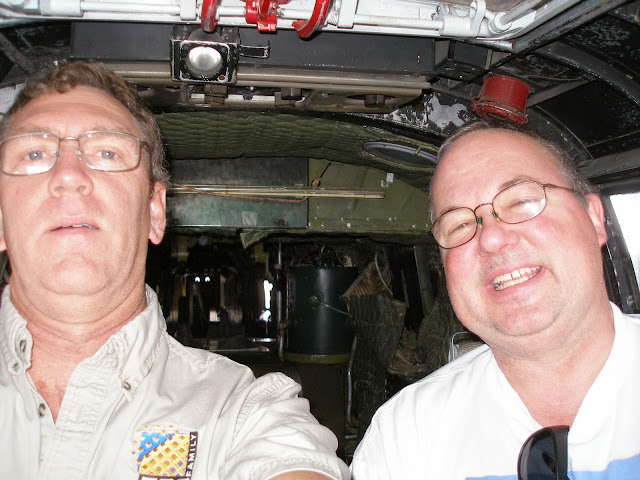
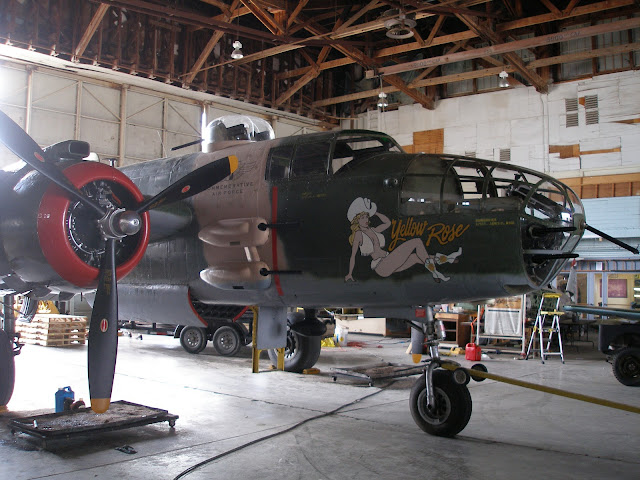
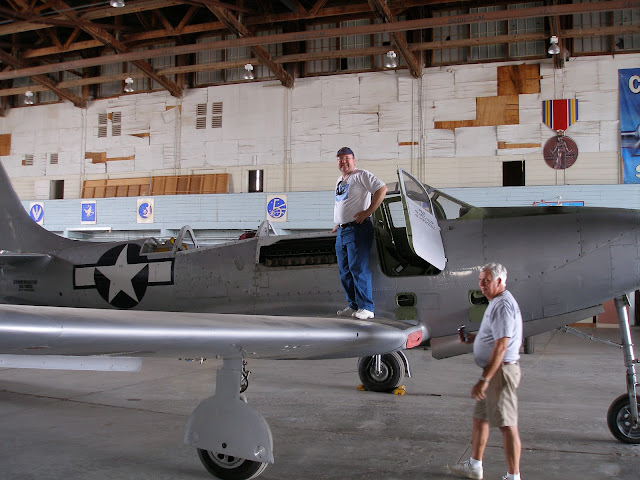
On Sunday I took Lynne up for her first flight. We started about 10, and it was already a bit bumpy by then, but she did fine. We toured the lakes, and then had brunch at the T82 Airport Diner.
After leaving we did a flight over Enchanted Rock. She enjoyed the flight, and we're starting to plan the next real trip.
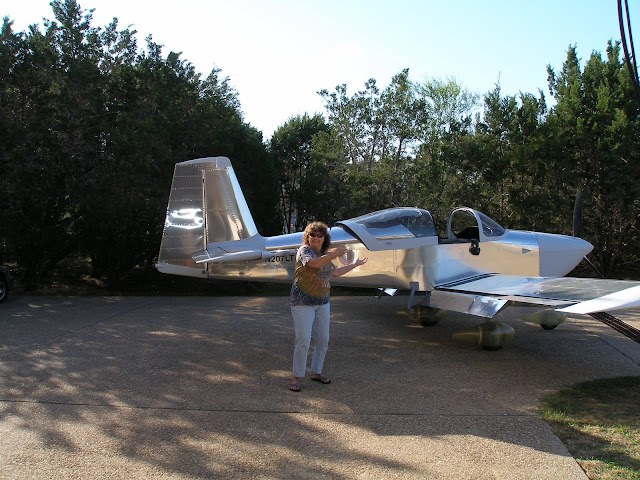
Monday morning I took up my boss, David Huebel, during our regularly scheduled meeting time. He brought his camera and took a bunch of pictures. I'll have to post some when David sorts them out. Waiting for David I did one lap around the pattern. It was a perfect morning, cool, calm wind, great visibility. The plane rolled out on downwind at pattern altitude, on speed, with the right power setting, smooth as silk, followed by a great landing (with a wary eye out for deer). It made me look like I knew what I was doing!
Tonight I went for a short spin, .7, practicing turns, slow flight, a 45 degree spiraling descent. Reasonably smooth, all in all a good evening to fly.
Looking at my blog, I haven't posted about any of my passengers. So here we go.
First passenger was Wayne Wagner. Thanks to Wayne, my airplane has a home. He was also able to simulate flying with my Dad, so that part of the flight testing is complete! We just finished Wayne's electrical system and panel, and then we spent three evenings riveting on the forward top skin on his 7A project. Wayne is doing a fantastic job on the detail. He's going to have really nice airplane, lot's of power and a very capable panel.
Second passenger was Jim Darrah. Saturday we flew down to San Marcos and visited with Mike Collier at the Commemorative Air Force Hanger. Mike is a fellow Lakeway Airpark board member, and he's one of the pilots for the warbirds the CAF has. He own's a BirdDog, and a T6 Texan. He was showing off the P63 King Cobra that is very close to flying. We got to sit in the B25 and ask lots of questions.
Jim was wearing his B-29 Fifi tshirt that day - what else do you wear when spending a day geeking out on airplanes? So Jim is driving to Lakeway to meet me when Fifi, the worlds only flying B-29, flies right over him! The B-29 and a B-17 happened to be at Bergstrom that day. They made multiple flights using 3R9 as a waypoint. I was able to see the B-17 later in the day. Verrry Cool!
On Sunday I took Lynne up for her first flight. We started about 10, and it was already a bit bumpy by then, but she did fine. We toured the lakes, and then had brunch at the T82 Airport Diner.
After leaving we did a flight over Enchanted Rock. She enjoyed the flight, and we're starting to plan the next real trip.
Monday morning I took up my boss, David Huebel, during our regularly scheduled meeting time. He brought his camera and took a bunch of pictures. I'll have to post some when David sorts them out. Waiting for David I did one lap around the pattern. It was a perfect morning, cool, calm wind, great visibility. The plane rolled out on downwind at pattern altitude, on speed, with the right power setting, smooth as silk, followed by a great landing (with a wary eye out for deer). It made me look like I knew what I was doing!
Tonight I went for a short spin, .7, practicing turns, slow flight, a 45 degree spiraling descent. Reasonably smooth, all in all a good evening to fly.
Monday, October 17, 2011
Phase 2
I took advantage of nice weather this weekend and finished flying the 40 hours of Phase 1 flight testing. That included redoing climb performance data at a lighter weight with the wheel fairings installed. This allowed me to establish the Vx and Vy speeds for the new configuration. I also repeated stall testing. Then I loaded the passenger seat back up and flew again, doing stability checks, more climb data and descent data.
I also ran climb to altitude tests over several flights to measure fuel consumption, time to climb, and distance from departure point for +3000, +6000, and +9000 foot departures. The climb to 4000 feet only burns .8 gallons, and that includes starting the engine, taxiing, runup, takeoff, and the climb (starting from 900ft). The climb to 10000 took only 2.8 gallons, and got the plane 27 nautical miles toward the destination.
Somewhere in all that testing I landed at Fredricksburg and had lunch at the airport diner.
The final flight of the 40 hours was a trip to KAUS (Bergstrom) with 200 lbs in the right seat, and 80 1bs in the baggage compartment. I wanted to check the operation of the localizer and glide slope information on the ILS approach to 17L. Unfortunately it didn't work. I guess I should rule out the ILS being out of service before I declare my equipment not working.
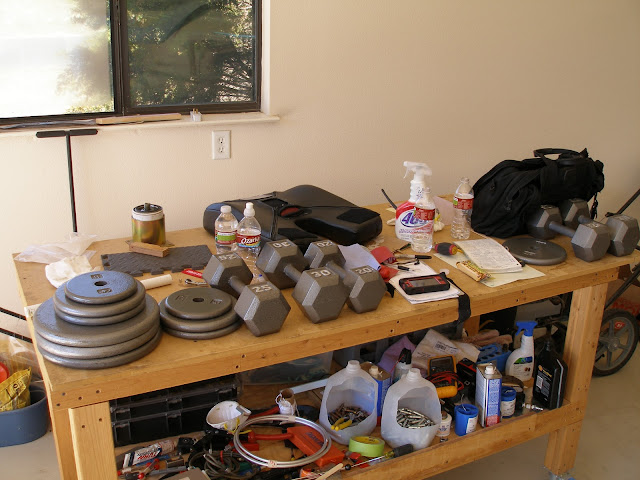
All this weight was in the airplane!
So with 40 hours, Vx, Vy, and Vso (stall speed with full flaps) and all the important testing and data collection done, I made the aircraft log book entry to officially end Phase 1. So my operating limitations are relaxed. I can now take a passenger, fly at night, fly over populated areas and in congested airways during cruise (which I'll tend to avoid anyway), and file an instrument flight plan.
Another interesting thing happened. I had been burning about a quart every 6 hours. When doing climb testing, it was much more, like 1 quart every 2 hours, which might mean it was going out the breather tube. With the wheel fairing on, I can fly about 10 knots faster, which allows the prop to finally turn at full RPM. In fact I can now redline the engine at 2700, which I couldn't do without the wheel fairings. With the faster cruise and high RPM/manifold pressure, I am able to really push the engine hard in cruise. So after about an hour of that, the oil consumption has dropped so that I've probably only burned 1/8 quart in the last 3 hours. Which hopefully means that the rings are seated and the engine is broken in. We'll see how the next 10 hours go.
And finally, on the same day, I went over 300 hours and 500 landings, and my repairmans certificate came in the mail. What a weekend!
I also ran climb to altitude tests over several flights to measure fuel consumption, time to climb, and distance from departure point for +3000, +6000, and +9000 foot departures. The climb to 4000 feet only burns .8 gallons, and that includes starting the engine, taxiing, runup, takeoff, and the climb (starting from 900ft). The climb to 10000 took only 2.8 gallons, and got the plane 27 nautical miles toward the destination.
Somewhere in all that testing I landed at Fredricksburg and had lunch at the airport diner.
The final flight of the 40 hours was a trip to KAUS (Bergstrom) with 200 lbs in the right seat, and 80 1bs in the baggage compartment. I wanted to check the operation of the localizer and glide slope information on the ILS approach to 17L. Unfortunately it didn't work. I guess I should rule out the ILS being out of service before I declare my equipment not working.
All this weight was in the airplane!
So with 40 hours, Vx, Vy, and Vso (stall speed with full flaps) and all the important testing and data collection done, I made the aircraft log book entry to officially end Phase 1. So my operating limitations are relaxed. I can now take a passenger, fly at night, fly over populated areas and in congested airways during cruise (which I'll tend to avoid anyway), and file an instrument flight plan.
Another interesting thing happened. I had been burning about a quart every 6 hours. When doing climb testing, it was much more, like 1 quart every 2 hours, which might mean it was going out the breather tube. With the wheel fairing on, I can fly about 10 knots faster, which allows the prop to finally turn at full RPM. In fact I can now redline the engine at 2700, which I couldn't do without the wheel fairings. With the faster cruise and high RPM/manifold pressure, I am able to really push the engine hard in cruise. So after about an hour of that, the oil consumption has dropped so that I've probably only burned 1/8 quart in the last 3 hours. Which hopefully means that the rings are seated and the engine is broken in. We'll see how the next 10 hours go.
And finally, on the same day, I went over 300 hours and 500 landings, and my repairmans certificate came in the mail. What a weekend!
Wednesday, October 12, 2011
Flew today with the wheel fairings on. They survived the trip and seem to be sturdy enough to trust for more flights.

Started with a climb to 4000 to measure fuel consumption, but realized that having the plane sit for a week throws off any measurements. During preflight I opened the right tank and fuel gushed out, it had expanded since filling it up. I'll have to repeat the experiment right after filling up. The climb took me 7nm from the airport. CHTs were OK, but I did reduce power and flatten the climb a little to make sure they stayed OK.
I was seeing 1300 fpm when climbing at 80 knots, no pax weight, 15 lbs in the back, but I wasn't too focused on that.
An 80 kt descent only lost 600 ft in 1 minute. The prop was turning 1000, and I think all the power was out.
I did a few speed points, at 3800 ft, setting manifold pressure to an even number.
At WOT I can now redline the engine. I couldn't do that before. In fact I have to back the throttle off quite a bit to stay below redline. I briefly saw 140 knots indicated, but it was slightly bumpy and the airspeed is the first thing to start jumping around if the air isn't perfectly smooth. But the plane is clearly faster with the fairings, at least 8 knots faster.
Started with a climb to 4000 to measure fuel consumption, but realized that having the plane sit for a week throws off any measurements. During preflight I opened the right tank and fuel gushed out, it had expanded since filling it up. I'll have to repeat the experiment right after filling up. The climb took me 7nm from the airport. CHTs were OK, but I did reduce power and flatten the climb a little to make sure they stayed OK.
I was seeing 1300 fpm when climbing at 80 knots, no pax weight, 15 lbs in the back, but I wasn't too focused on that.
An 80 kt descent only lost 600 ft in 1 minute. The prop was turning 1000, and I think all the power was out.
I did a few speed points, at 3800 ft, setting manifold pressure to an even number.
At WOT I can now redline the engine. I couldn't do that before. In fact I have to back the throttle off quite a bit to stay below redline. I briefly saw 140 knots indicated, but it was slightly bumpy and the airspeed is the first thing to start jumping around if the air isn't perfectly smooth. But the plane is clearly faster with the fairings, at least 8 knots faster.
Tuesday, October 11, 2011
Stopped by the hangar and put the seats back in, so the cabin is ready to fly. Also got the upper cowl in place, but it still needs to be fastened.
Removed the main gear fairings and brought them home.
After dinner, mixed up some epoxy and flox and bonded the intersection fairings to the wheel fairings. I expect this to work very well, and I may even be able to fly tomorrow.


The nose wheel fairing has cured nicely. I slopped on the epoxy, and it is really hard to sand off. It's going to take a while to get it ready for painting. Because of this, I was much more careful with the main gear fairings.
Removed the main gear fairings and brought them home.
After dinner, mixed up some epoxy and flox and bonded the intersection fairings to the wheel fairings. I expect this to work very well, and I may even be able to fly tomorrow.
The nose wheel fairing has cured nicely. I slopped on the epoxy, and it is really hard to sand off. It's going to take a while to get it ready for painting. Because of this, I was much more careful with the main gear fairings.
Monday, October 10, 2011
Spent the weekend working on the gear leg fairings and wheel fairings. Installed 30 nutplates yesterday between the upper intersection fairings and the wheel fairing halves.
Saturday I fit a small intersection fairing to the front of the nosewheel fairing. Not overly happy with the work I did on the nosewheel gear leg fairing, which needed trimming to clear the intersection fairing. Tonight I got the main wheel fairings in place with screws and then fit the lower intersection fairings and got them trimmed and clecoed into place. Next step is to bond the intersection fairings into place.
I need to hurry, the next few days will be really nice for flying
Saturday I fit a small intersection fairing to the front of the nosewheel fairing. Not overly happy with the work I did on the nosewheel gear leg fairing, which needed trimming to clear the intersection fairing. Tonight I got the main wheel fairings in place with screws and then fit the lower intersection fairings and got them trimmed and clecoed into place. Next step is to bond the intersection fairings into place.
I need to hurry, the next few days will be really nice for flying
Sunday, October 9, 2011
60 rivets today, installing nutplates for the gear leg intersection fairings and for the wheel fairing halves. As far as I can remember, these are the last rivet I have to set. My spreadsheet gives the total as 17111. About 2700 hours, but I stopped tracking hours accurately at 2650.

Got the interior mostly put back together, should have the plane flight ready by the end of tomorrow evening, this time with wheel fairings installed. Still need to glass on all the lower intersection fairings.
IFR conditions all day. We got almost 2 inches of rain last night. It was desperately needed.
Wayne is essentially finished with his panel wiring. We are shifting gears on his project, and got the brakes charged. Top skin riveting will happen soon.
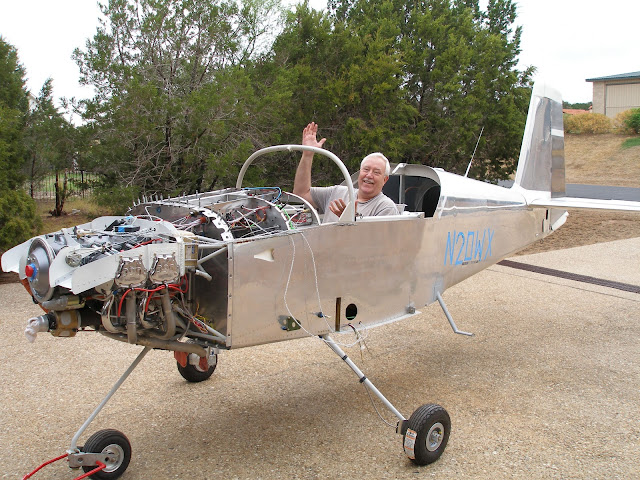
Got the interior mostly put back together, should have the plane flight ready by the end of tomorrow evening, this time with wheel fairings installed. Still need to glass on all the lower intersection fairings.
IFR conditions all day. We got almost 2 inches of rain last night. It was desperately needed.
Wayne is essentially finished with his panel wiring. We are shifting gears on his project, and got the brakes charged. Top skin riveting will happen soon.
Thursday, October 6, 2011
Confidence is growing that I resolved the stray fuel smell problem by tightening up that right vent line fitting. I ran a test card Wednesday night (150+45) and did not smell any fuel during the steep attitudes. As the CG shifts aft, the plane definitely gets more squirrely. It has almost neutral stability in the slip test that the card performs. This might have been due to a less than smooth ride. All the other tests were fine, although stall behaviour is incrementally less polite.
On returning I refueled. This took care of one of the test items. Climb to 3000 feet (from 900 feet), including startup, short taxi, runup and takeoff: .8 gallons. Call it 1. Another data point for the Pilots Operating Handbook. And I think I have the fuel flow adjusted pretty close to correct. It's registers a slight bit more than I actually use, but that's better than the other way around. I need to check this more, but I also need to look closely at the fuel tank levels to make sure they are reasonable.
That flight got me to 33 hours, 7 to go.
We have cloudy weather for the next few days, so I decided to take the plane out of service and get the gear fairings installed. The first part of this is removing the seat pans so I can install nutplates.s
So tonight I took out the seat pans, and inspected the wiring runs. It all looks OK after 30 hours. I also took out the aileron trim and brought it home. I cut an ample notch for clamping pressure and now I should be able to use the aileron trim.
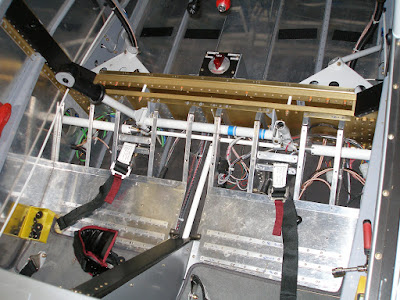
On returning I refueled. This took care of one of the test items. Climb to 3000 feet (from 900 feet), including startup, short taxi, runup and takeoff: .8 gallons. Call it 1. Another data point for the Pilots Operating Handbook. And I think I have the fuel flow adjusted pretty close to correct. It's registers a slight bit more than I actually use, but that's better than the other way around. I need to check this more, but I also need to look closely at the fuel tank levels to make sure they are reasonable.
That flight got me to 33 hours, 7 to go.
We have cloudy weather for the next few days, so I decided to take the plane out of service and get the gear fairings installed. The first part of this is removing the seat pans so I can install nutplates.s
So tonight I took out the seat pans, and inspected the wiring runs. It all looks OK after 30 hours. I also took out the aileron trim and brought it home. I cut an ample notch for clamping pressure and now I should be able to use the aileron trim.
Wednesday, October 5, 2011
Got in another hour yesterday, flying test card 12d, 125 in the right seat and 25 in the baggage. Next up is 150 + 45.
Found problem that's been nagging me. When ever I had a steep attitude, during climbs or stalls, I would get a smell of fuel. And occasionally on the ground. I had somewhat suspected the vents, but I kept looking at the fuel selector with greater suspicion.
Yesterday I refueled after the morning flight, so the fuel was cool. I pushed out of the hangar in the afternoon and the warmer air made the fuel expand. I was noticing a fuel smell when I saw it: A drip of fuel from the lower right fuel vent fittings. These are routed inside the cockpit. It was actually dripping!
I put a wrench on it. I appeared it had never been tightened. After all the inspections, nobody caught it, especially me. These vent lines blend in to the background and don't get much attention. We'll see if this fixes the fuel smell during flight.
Found problem that's been nagging me. When ever I had a steep attitude, during climbs or stalls, I would get a smell of fuel. And occasionally on the ground. I had somewhat suspected the vents, but I kept looking at the fuel selector with greater suspicion.
Yesterday I refueled after the morning flight, so the fuel was cool. I pushed out of the hangar in the afternoon and the warmer air made the fuel expand. I was noticing a fuel smell when I saw it: A drip of fuel from the lower right fuel vent fittings. These are routed inside the cockpit. It was actually dripping!
I put a wrench on it. I appeared it had never been tightened. After all the inspections, nobody caught it, especially me. These vent lines blend in to the background and don't get much attention. We'll see if this fixes the fuel smell during flight.
Monday, October 3, 2011
Put in about 4 hours over the weekend. Started by changing oil on Friday. That was at 20 tach hours. About 28 on the hobbs. Also took out the #2 bottom plug and cleaned it up real good. It ran very well for a while. Saturday, flew to Georgetown to meet Seth and pickup a new spark plug and a spare wire harness. Next time the lower cowl is off I'll trade out the harness to see if it makes any difference. When routing wires for the bottom left side (#2 and #4), I used Adel clamps that may have been a bit too small. If the new harness fixes the issues, that may be the actual cause. If not, then it may just be a break in issue.
Back to Georgetown, I got to meet the local RV dignitaries that had just done an overhead break arrival. Stu, the Card's, R.W., and Bobby L. (who I had met a year earlier at Seth's shop). I wanna be able to be part of a four ship overhead break! It looks cool!
I had planned on zipping down to San Marcos to visit Mike who has a T6 at the warbird hangars. But a mag check showed that #4 bottom plug was not firing. Dang. The engine was running OK on both mags, so I scrubbed San Marcos and returned to Lakeway to fix the problem. That plug was firing fine by the time I got back and pulling it showed it wasn't too bad. I think my leaning habits on the ground need to be improved. These engines are bit finicky.
With that problem resolved, Sunday I flew a planned circle around Austin. The route was 3R9, KERV, KSSF, T20, 3TG, KRWV, KPWG, KMNZ (these last two about two miles out of my 75nm circle, so I didn't actually overfly them), and then 81R, T92, then back to Lakeway.

I flew the first half on plan. Picked up flight following around San Antonio, verified altitude with the controllers, and stopped at Fayette Regional for a break. What a treat. I walked in and fell in love with the place. No one else there. This great little airport embodies what I love about small airports. I took a bunch of pictures with the iphone, but only one turned out acceptable.
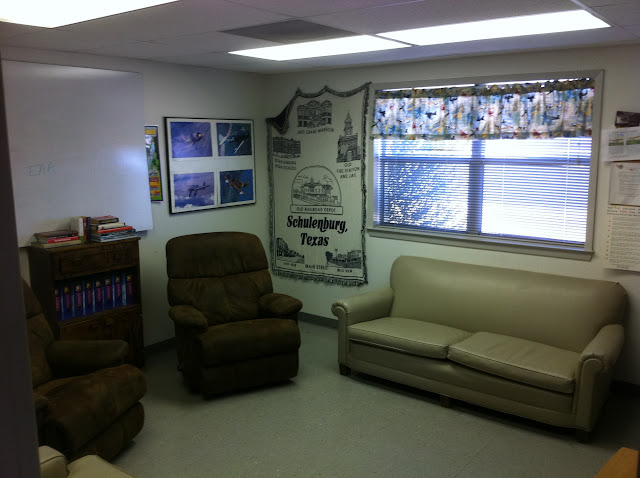

Finally coming over the north side of the Hood MOA (which was not active) I was getting unnecessarily nervous about fuel, so I stopped in Lampassas. I had been cruising at 6500, where it was glass smooth. On the descent, at about 5000, it started getting rough. The days heating had kicked in.
Refueled and then just returned to Lakeway. I was hungry, and didn't feel like getting beat up by thermals.
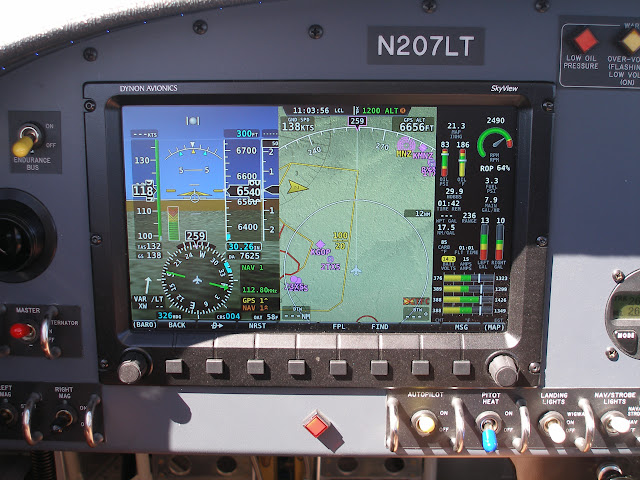
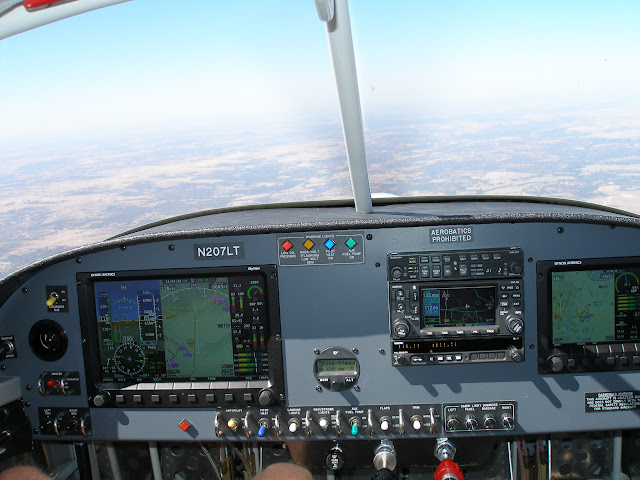
Skyview in action.
Finished the weekend at 30.9, only 9 hours to go!
Back to Georgetown, I got to meet the local RV dignitaries that had just done an overhead break arrival. Stu, the Card's, R.W., and Bobby L. (who I had met a year earlier at Seth's shop). I wanna be able to be part of a four ship overhead break! It looks cool!
I had planned on zipping down to San Marcos to visit Mike who has a T6 at the warbird hangars. But a mag check showed that #4 bottom plug was not firing. Dang. The engine was running OK on both mags, so I scrubbed San Marcos and returned to Lakeway to fix the problem. That plug was firing fine by the time I got back and pulling it showed it wasn't too bad. I think my leaning habits on the ground need to be improved. These engines are bit finicky.
With that problem resolved, Sunday I flew a planned circle around Austin. The route was 3R9, KERV, KSSF, T20, 3TG, KRWV, KPWG, KMNZ (these last two about two miles out of my 75nm circle, so I didn't actually overfly them), and then 81R, T92, then back to Lakeway.
I flew the first half on plan. Picked up flight following around San Antonio, verified altitude with the controllers, and stopped at Fayette Regional for a break. What a treat. I walked in and fell in love with the place. No one else there. This great little airport embodies what I love about small airports. I took a bunch of pictures with the iphone, but only one turned out acceptable.
Finally coming over the north side of the Hood MOA (which was not active) I was getting unnecessarily nervous about fuel, so I stopped in Lampassas. I had been cruising at 6500, where it was glass smooth. On the descent, at about 5000, it started getting rough. The days heating had kicked in.
Refueled and then just returned to Lakeway. I was hungry, and didn't feel like getting beat up by thermals.
Skyview in action.
Finished the weekend at 30.9, only 9 hours to go!
Thursday, September 29, 2011
Snuck in .8 this morning, ran test card 12a, which puts 80 lbs of weight in the right seat and then checks stalls, climbs, descents, stability, turns, etc.. It was a perfect morning, glass smooth, relatively cool, so it was almost cheating. The 1260 fpm 90 knot climb rate was better than the rate with no weight, which probably means I'm just getting better at flying the plane. The 80 knot idle power descent rate was around 800 fpm, right at what earlier tests showed with no extra weight.
Still fighting a fouled plug on #2 cylinder, will try trading out plugs one more time. I will change the oil tomorrow, 24 hours is enough for the breakin oil.
Oil consumption was running about 1 quart in about 6 hours. It seems like it jumped up a little recently.
I took the upper cowl off earlier this week and we found a small oil leak from the sender manifold. There are two oil pressure guages and 7 different connections that could leak. Tightened them up and we'll see how they did when I take the cowl off again tomorrow.
Let's see, what have I missed posting in the last 3 weeks. Landing and refueling in Lampassas. Touch n goes at Burnett. Full stop landing at Burnett and visiting the FBO just cause I can. Lunch and a plane visit with the gang from work. Lunch at the airport diner in Fredricksburg. Miserably hot and bumpy conditions on the way home at 5500 ft.

Cav with the Hangar Hotel in the background.
I have stall speeds. Vs, stall speed with no flaps is 51 knots. Vso, stall speed with full flaps is 42 knots. Not much warning between buffet and stall. Buffeting seemed to happen sooner with more weight. Vx is about 75, Vy is around 80, at least with the data I have now, which was taken with only the nose gear leg fairing. Wide open throttle speed is 132 knots, or a true airspeed of 144 knots. Climb rates of about 1300 fpm with a light load. The airframe passes the stability tests.
This data is sufficient to sign the airframe logbook at the end of the 40 hour period, but I still need to take data with wheel fairings in place.
Speaking of which, I've been inching closer on the fairings, and I may try to drill the main gear intersection fairings this weekend or next week. Once that's done, I can glass the lower intersection fairings to the wheel fairings, and then finally fly with my pants on! Wheel pants, that is.
I've also been working on finishing the glare shield cover and edge trim. Cut a sheet of .016 to fit under the canopy, and bought new glare shield material from Cleaveland. The first attempt at glueing didn't work too well, but I hope to fix this up this week as well.
Still fighting a fouled plug on #2 cylinder, will try trading out plugs one more time. I will change the oil tomorrow, 24 hours is enough for the breakin oil.
Oil consumption was running about 1 quart in about 6 hours. It seems like it jumped up a little recently.
I took the upper cowl off earlier this week and we found a small oil leak from the sender manifold. There are two oil pressure guages and 7 different connections that could leak. Tightened them up and we'll see how they did when I take the cowl off again tomorrow.
Let's see, what have I missed posting in the last 3 weeks. Landing and refueling in Lampassas. Touch n goes at Burnett. Full stop landing at Burnett and visiting the FBO just cause I can. Lunch and a plane visit with the gang from work. Lunch at the airport diner in Fredricksburg. Miserably hot and bumpy conditions on the way home at 5500 ft.
Cav with the Hangar Hotel in the background.
I have stall speeds. Vs, stall speed with no flaps is 51 knots. Vso, stall speed with full flaps is 42 knots. Not much warning between buffet and stall. Buffeting seemed to happen sooner with more weight. Vx is about 75, Vy is around 80, at least with the data I have now, which was taken with only the nose gear leg fairing. Wide open throttle speed is 132 knots, or a true airspeed of 144 knots. Climb rates of about 1300 fpm with a light load. The airframe passes the stability tests.
This data is sufficient to sign the airframe logbook at the end of the 40 hour period, but I still need to take data with wheel fairings in place.
Speaking of which, I've been inching closer on the fairings, and I may try to drill the main gear intersection fairings this weekend or next week. Once that's done, I can glass the lower intersection fairings to the wheel fairings, and then finally fly with my pants on! Wheel pants, that is.
I've also been working on finishing the glare shield cover and edge trim. Cut a sheet of .016 to fit under the canopy, and bought new glare shield material from Cleaveland. The first attempt at glueing didn't work too well, but I hope to fix this up this week as well.
Wednesday, September 28, 2011
Monday, September 5, 2011
A busy long weekend. Got in 4 flights, two today. I can fly twice in one day!
I've started venturing away from Lakeway, going all the way up to Lampassas, then down to Fredricksburg. Haven't landed at another airport yet, but that will happen soon.
On Sunday morning I started on flight test card 5, doing 2 minute climbs at various airspeeds. I did this out south and east of Horseshoe Bay, trying to stay somewhere close to a emergency landing site. Also did some low power descents, but at 1300 the engine still produces quite a bit of thrust. Checked the VOR nav reciever enough to verify it receives a station.
By late Sunday, fires had developed in the area. There was no trace of them Sunday morning. But by Monday there were some serious fires.

Here's the satellite photo from Monday evening. All the patches over Texas are fires (except a few clouds over the valley).
This morning on the LZZ T82 triangle I did a thorough checkout of the NAV receiver. It seems to work great. Still a couple of items to check, but the 430W VOR receiver and Archer antenna seem to be a usable combination. I was even able to tune into the HIWAS on the LLO VOR audio, so the audio hookup to the audio panel is working as designed. So far the radios are all working as expected, but there are a few finesse points to using them correctly.
Also turned on the autopilot for the first time. It did the basic heading and altitude hold with no bad habits. Next I need to check VS and set altitude modes, then GPS steering.
A freak early "cold" front passed through yesterday, so the winds today were strong and gusty from the north. I managed a passable landing this morning despite the conditions.
Then this evening winds had died down so went up for another short flight. Got in some slow flight and 45 degree turns, out east of Burnett. There are nice emergency fields up there, including lots of private strips, although I could only find a few of them from the air. The fire south of Spicewood was going strong, but another fire, maybe up in the Fort Hood area was fouling the air over Lakeay. A TFR for the Spicewood fire was in effect. It did not show up on the web page when I checked before leaving. Fortunately I steered well away, so I managed to just skirt the edge of the TFR coming back into Lakeway. I did not bust that TFR. Whew!
10 hours on the Hobbs now.
I've started venturing away from Lakeway, going all the way up to Lampassas, then down to Fredricksburg. Haven't landed at another airport yet, but that will happen soon.
On Sunday morning I started on flight test card 5, doing 2 minute climbs at various airspeeds. I did this out south and east of Horseshoe Bay, trying to stay somewhere close to a emergency landing site. Also did some low power descents, but at 1300 the engine still produces quite a bit of thrust. Checked the VOR nav reciever enough to verify it receives a station.
By late Sunday, fires had developed in the area. There was no trace of them Sunday morning. But by Monday there were some serious fires.

Here's the satellite photo from Monday evening. All the patches over Texas are fires (except a few clouds over the valley).
This morning on the LZZ T82 triangle I did a thorough checkout of the NAV receiver. It seems to work great. Still a couple of items to check, but the 430W VOR receiver and Archer antenna seem to be a usable combination. I was even able to tune into the HIWAS on the LLO VOR audio, so the audio hookup to the audio panel is working as designed. So far the radios are all working as expected, but there are a few finesse points to using them correctly.
Also turned on the autopilot for the first time. It did the basic heading and altitude hold with no bad habits. Next I need to check VS and set altitude modes, then GPS steering.
A freak early "cold" front passed through yesterday, so the winds today were strong and gusty from the north. I managed a passable landing this morning despite the conditions.
Then this evening winds had died down so went up for another short flight. Got in some slow flight and 45 degree turns, out east of Burnett. There are nice emergency fields up there, including lots of private strips, although I could only find a few of them from the air. The fire south of Spicewood was going strong, but another fire, maybe up in the Fort Hood area was fouling the air over Lakeay. A TFR for the Spicewood fire was in effect. It did not show up on the web page when I checked before leaving. Fortunately I steered well away, so I managed to just skirt the edge of the TFR coming back into Lakeway. I did not bust that TFR. Whew!
10 hours on the Hobbs now.
Saturday, September 3, 2011
Got a flight in this morning, #4, 2.0 hrs. My primary purpose was to burn holes in the sky to break in the engine. So I ran at 2600 up to full throttle between Lago Vista and Horseshoe Bay, I started at 4500 on the first west bound leg, then climbed to 5500 east bound, then up ot 6500. OATs were a nice 66 degrees, and it was almost comfortable in the cabin. There were sparse clouds to the west at about 4900, but I was soon above them.
The stuttering with leaning is gone, I guess it was the dropped bottom #4 plug that I replaced. Let that be a lesson.
CHTs popped up to 435 on 3 and 4 during the initial climb, but they all came down and were mostly green the whole time. EGTs can peak at about 1500, but with power at about 75% they run at 1350 or so. Fuel flow is a bit higher than I want, at 75% it wants to be at 9 gph.
Oil temp never got above 200 today. It was a bit cooler, the nasty heat we had in August seems to have left. I'm still wary, it could be back as soon as the storm in Louisiana is gone.
Durning the week I adjusted the left flap and right aileron to improve the heavy wing problem. It seems to be a non-issue, although the aileron trim is still not usable for leveling the wings.
I started, departed, and left the fuel selector on the left tank to see how much I had to burn to get neutral roll trim. The answer was about 7 gallons. So at that point I had 12 in the right, and 5 in the left. So I switched tanks.
The only odd problem I had today, is that after switching tanks and running a while,
the left tank was still going down, while the right was pegged at 12 gallons. At the time I was wondering what the heck. I discovered this on the way out to Horseshoe Bay. It occurred to me that I was going away from Lakeway with only one working tank, and only 4 gallons in that tank. I realized that was a problem so I turned around. In retrospect, I think it was just the left tank fuel level pickup settling out a bit. There can't be a real problem with the fuel selector. The engine was running fine, and the right tank finally did start registering lower levels.
The test flight cards had me do some slow flight, so I did that on the last lap back into Lakeway. I got it down to 70, 60, and finally 50 while maintaing altitude and making shallow turns. The fuel flow drops to about 3 gph, and the engine temps all go yellow because they're too low!
The plane flies great at 100 knots, and sips fuel. I was seen 135 knots indicated today at 2600, 150 knot ground speeds.
Flying at 9AM means it has been nearly glass smooth most of the time.
The stuttering with leaning is gone, I guess it was the dropped bottom #4 plug that I replaced. Let that be a lesson.
CHTs popped up to 435 on 3 and 4 during the initial climb, but they all came down and were mostly green the whole time. EGTs can peak at about 1500, but with power at about 75% they run at 1350 or so. Fuel flow is a bit higher than I want, at 75% it wants to be at 9 gph.
Oil temp never got above 200 today. It was a bit cooler, the nasty heat we had in August seems to have left. I'm still wary, it could be back as soon as the storm in Louisiana is gone.
Durning the week I adjusted the left flap and right aileron to improve the heavy wing problem. It seems to be a non-issue, although the aileron trim is still not usable for leveling the wings.
I started, departed, and left the fuel selector on the left tank to see how much I had to burn to get neutral roll trim. The answer was about 7 gallons. So at that point I had 12 in the right, and 5 in the left. So I switched tanks.
The only odd problem I had today, is that after switching tanks and running a while,
the left tank was still going down, while the right was pegged at 12 gallons. At the time I was wondering what the heck. I discovered this on the way out to Horseshoe Bay. It occurred to me that I was going away from Lakeway with only one working tank, and only 4 gallons in that tank. I realized that was a problem so I turned around. In retrospect, I think it was just the left tank fuel level pickup settling out a bit. There can't be a real problem with the fuel selector. The engine was running fine, and the right tank finally did start registering lower levels.
The test flight cards had me do some slow flight, so I did that on the last lap back into Lakeway. I got it down to 70, 60, and finally 50 while maintaing altitude and making shallow turns. The fuel flow drops to about 3 gph, and the engine temps all go yellow because they're too low!
The plane flies great at 100 knots, and sips fuel. I was seen 135 knots indicated today at 2600, 150 knot ground speeds.
Flying at 9AM means it has been nearly glass smooth most of the time.
Sunday, August 28, 2011
Yesterday stripped off the last remaining blue plastic and installed the wing walk material.
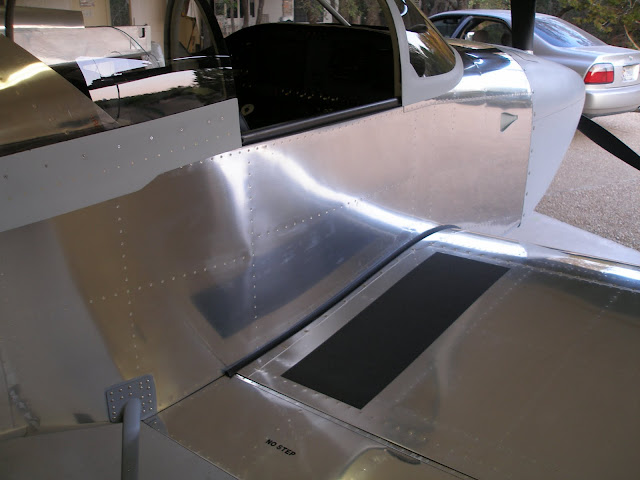
Installed extra return springs on the pilot side brake master cylinders. They're not perfect yet, but these made a huge difference. Now I almost look like I know what I'm doing when I taxi. Much more controlable on the ground.
Emptied the tanks last night and then filled them up 2 gallons at a time to calibrate them. The process worked, I might want to redo the right side sometime, it took a while to figure out the optimal method. The left tank should be spot on.
Flew this morning. Before starting I adjusted the SL-40 sidetone, and it now works perfectly.
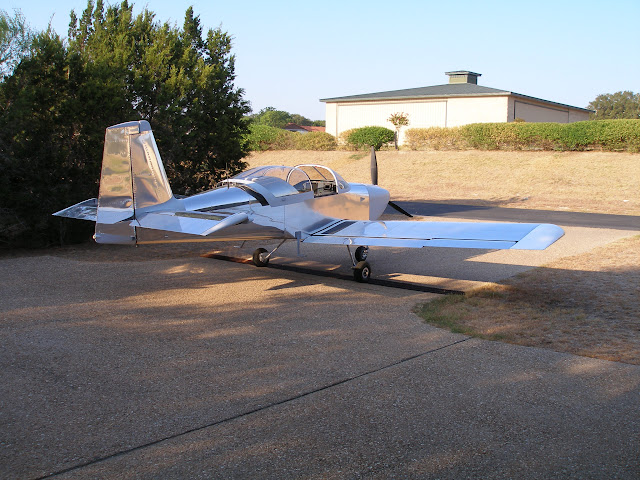
0900 - ready to fly
Ran for about 2 hours today, and ventured away from home, over to the next airstrip, Lago Vista. It made a nice 8 mile race race track and gave me some straight and level time. I ran the engine at about 74% and leaned it out some, watching how the temperatures behave. Still running a bit rich. 3 and 4 hitting about 423, this seems to be about the peak for them, 1 and 2 heat up considerably from there. Oil temps about 212, 218 max. The engine stutters a bit when leaned. It goes away when the mixture is enrichened. Carb heat seems to work, and actually cools off all the cylinders.
Talked with Austin Approach, got a squawk code, ident, and they verified altitude. Transponder checks out, along with the static system.
Also got in a bit more slow flight, doing a few 360s at 62 knots. She flies well at this slow speed, no bad habits, just floating in the air.
Ambient today started at about 90, and was about 100 when I stopped.
The 430W was having receive problems. But it checked out perfectly back on the ground. I think I was setting the radios and audio panel wrong somehow, managing two frequencies very close together. Transmitting on the 430W still spikes the CHTs.
And here's a shot of the upper cowling. There are three airleaks from the baffle material, just in front of 3 and 4. Incidentally, those are the hottest cylinders.
Installed extra return springs on the pilot side brake master cylinders. They're not perfect yet, but these made a huge difference. Now I almost look like I know what I'm doing when I taxi. Much more controlable on the ground.
Emptied the tanks last night and then filled them up 2 gallons at a time to calibrate them. The process worked, I might want to redo the right side sometime, it took a while to figure out the optimal method. The left tank should be spot on.
Flew this morning. Before starting I adjusted the SL-40 sidetone, and it now works perfectly.
0900 - ready to fly
Ran for about 2 hours today, and ventured away from home, over to the next airstrip, Lago Vista. It made a nice 8 mile race race track and gave me some straight and level time. I ran the engine at about 74% and leaned it out some, watching how the temperatures behave. Still running a bit rich. 3 and 4 hitting about 423, this seems to be about the peak for them, 1 and 2 heat up considerably from there. Oil temps about 212, 218 max. The engine stutters a bit when leaned. It goes away when the mixture is enrichened. Carb heat seems to work, and actually cools off all the cylinders.
Talked with Austin Approach, got a squawk code, ident, and they verified altitude. Transponder checks out, along with the static system.
Also got in a bit more slow flight, doing a few 360s at 62 knots. She flies well at this slow speed, no bad habits, just floating in the air.
Ambient today started at about 90, and was about 100 when I stopped.
The 430W was having receive problems. But it checked out perfectly back on the ground. I think I was setting the radios and audio panel wrong somehow, managing two frequencies very close together. Transmitting on the 430W still spikes the CHTs.
And here's a shot of the upper cowling. There are three airleaks from the baffle material, just in front of 3 and 4. Incidentally, those are the hottest cylinders.
Saturday, August 27, 2011
I will stop tracking time as I did in the build, although there is still more work to do on construction (fiberglass fairings, yech) and of course fixing issues and on-going maintenance will both take time.
But now I'll just use this as more of a web log than a build log.
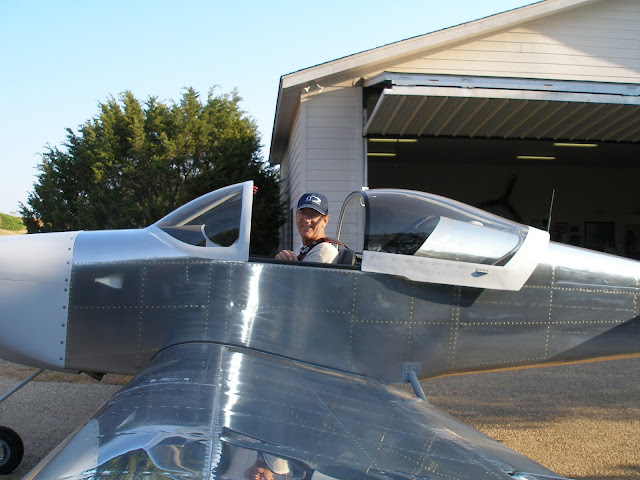
photos today by Suanne McLellan!
Flew this morning, 1.3 hrs on the hobbs, about 1.2 of that in the air. Engine start at 8:45 when it was still reasonbly cool. The plane flew great and the engine is running well except for an occasional quick stutter. I will have to keep an eye on that.
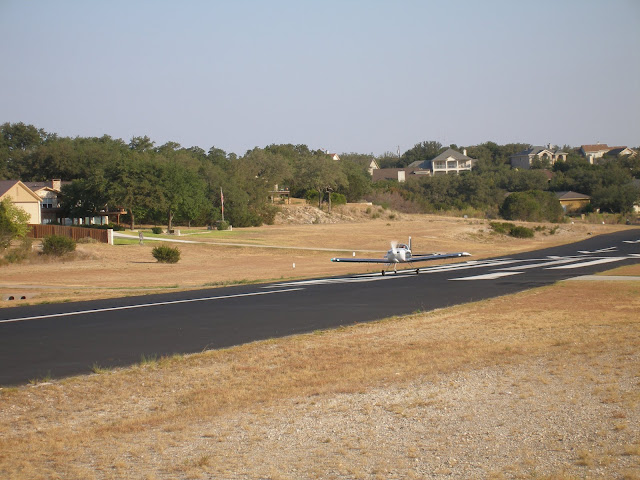
This time airspeed was good. I took it up to 2500 and the #4 CHT was running hot, about 430. #1 was still in the green, about 385. Flattened out the climb and continued up to 3300. #4 CHT stayed around 423, just one pixel of red, and I could keep it about there by adjusting climb rate. Set the throttle for 2500 and just started doing laps. Below me the airpark was busy. Dogs on the runway, deer, etc.
I also got a good look at my guages this time. Oil temp got up to 212 and stayed there, never hotter. Fuel flow was at 12 in the inital climb, backed off to 10.5 on the racetrack, and I later leaned it down to about 9.5. The EGT's climbed into the green range at about 1410 on leaning, but with a wide variance. Lot's to learn on the EGTs.
The left wing is a bit heavy, can't trim it out with aileron trim. It's not too noticeable until I've been holding it for 30 minutes and I try to fly straight and level.
The Dynon was telling me the wind was from the north at 11 knots at altitude. And it had shifted below me too.
At the end of about an hour I slowed down to start some slow flight. I got down to about 60 knots with full flaps, maintaining altitude and flying shallow banked turns. Then I recovered up to 100 knots and started my decent. The north wind was now favoring 34, and I joined the pattern for my first ever attempt at 34. All my other landings at lakeway were on 16. As I was about to join the pattern a flight of two taxied onto the runway for departure, so I climbed back up to 2500 and loitered to the west to wait for them. The first attempt was still hot and high so a go around was needed. But the second try was just about right, although the landing could have been better.
There it is, flight #2 in the books, a reasonable success. John and Suanne came out to watch and I gave her the camera. Everyone on the airpark is also taking a few minutes to watch, and come over to the airpark to congratulate me. Thanks everyone!
Squawks include the SL-40 is too loud when I transmit. The CHT's jump when I transmit on the 430W.
There are a couple of oil leaks, I think they might even be the plugs. I will remove one and replace the crush gasket. Readjusted the right side exhaust to improve cowling clearance. I will put springs on the draggy brakes later today.

Heavy left wing.
Need to calibrate the tanks.
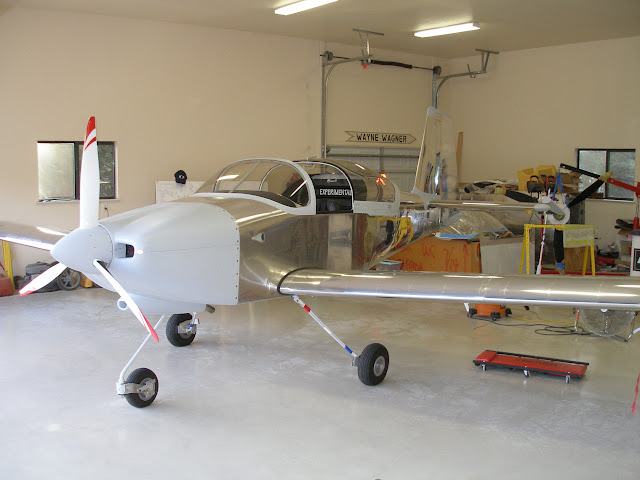
A flight ready RV-9A!
But now I'll just use this as more of a web log than a build log.
photos today by Suanne McLellan!
Flew this morning, 1.3 hrs on the hobbs, about 1.2 of that in the air. Engine start at 8:45 when it was still reasonbly cool. The plane flew great and the engine is running well except for an occasional quick stutter. I will have to keep an eye on that.
This time airspeed was good. I took it up to 2500 and the #4 CHT was running hot, about 430. #1 was still in the green, about 385. Flattened out the climb and continued up to 3300. #4 CHT stayed around 423, just one pixel of red, and I could keep it about there by adjusting climb rate. Set the throttle for 2500 and just started doing laps. Below me the airpark was busy. Dogs on the runway, deer, etc.
I also got a good look at my guages this time. Oil temp got up to 212 and stayed there, never hotter. Fuel flow was at 12 in the inital climb, backed off to 10.5 on the racetrack, and I later leaned it down to about 9.5. The EGT's climbed into the green range at about 1410 on leaning, but with a wide variance. Lot's to learn on the EGTs.
The left wing is a bit heavy, can't trim it out with aileron trim. It's not too noticeable until I've been holding it for 30 minutes and I try to fly straight and level.
The Dynon was telling me the wind was from the north at 11 knots at altitude. And it had shifted below me too.
At the end of about an hour I slowed down to start some slow flight. I got down to about 60 knots with full flaps, maintaining altitude and flying shallow banked turns. Then I recovered up to 100 knots and started my decent. The north wind was now favoring 34, and I joined the pattern for my first ever attempt at 34. All my other landings at lakeway were on 16. As I was about to join the pattern a flight of two taxied onto the runway for departure, so I climbed back up to 2500 and loitered to the west to wait for them. The first attempt was still hot and high so a go around was needed. But the second try was just about right, although the landing could have been better.
There it is, flight #2 in the books, a reasonable success. John and Suanne came out to watch and I gave her the camera. Everyone on the airpark is also taking a few minutes to watch, and come over to the airpark to congratulate me. Thanks everyone!
Squawks include the SL-40 is too loud when I transmit. The CHT's jump when I transmit on the 430W.
There are a couple of oil leaks, I think they might even be the plugs. I will remove one and replace the crush gasket. Readjusted the right side exhaust to improve cowling clearance. I will put springs on the draggy brakes later today.
Heavy left wing.
Need to calibrate the tanks.
A flight ready RV-9A!
Thursday, August 25, 2011
Other notes about yesterday's flight. I wanted to fly early in the day, but there were just too many things to finish up. Got these done at noon, but then I needed to cool off and get something to eat.
It was 1:13 when I started the engine, and 1:54 when I shut it off. Temperature was 106 F.
Central Texas is having it's worst summer ever, with a new record of 77 days over 100 set yesterday, with no end in sight. A strong, stable dome of high pressure has set up residence and it's going nowhere soon. The hurricanes that come anywhere close are swatted to the side like gnats. We had about 1.5 inches of rain in May or June, but that's the only significant rain we've had in almost a year. Trees are dying, the lake is way down, all the golf course ponds are drying up. And La Nina may be on the way back. It's going to get worse before it gets better.
It was 1:13 when I started the engine, and 1:54 when I shut it off. Temperature was 106 F.
Central Texas is having it's worst summer ever, with a new record of 77 days over 100 set yesterday, with no end in sight. A strong, stable dome of high pressure has set up residence and it's going nowhere soon. The hurricanes that come anywhere close are swatted to the side like gnats. We had about 1.5 inches of rain in May or June, but that's the only significant rain we've had in almost a year. Trees are dying, the lake is way down, all the golf course ponds are drying up. And La Nina may be on the way back. It's going to get worse before it gets better.
Wednesday, August 24, 2011
First Flight!
N207LT flew for the first time today.
Engine start at 1:13 and we took flight at 1:20pm. Wayne and Cora
were my ground crew.

She flew very well, except for the minor
distraction of no airspeed indicator. I check for controlability and then started a climb, turning to downwind about the same time. I thought for a second about returning immediately, but quickly decided to keep her in the air, climbing to 2000AGL. CHTs climbed pretty high, with #4 at 442. I backed out the power and lowered the nose and she cooled off nicely, staying around 400. Wish I could remember what the oil temp was. On the 430W I dialed up the page that shows ground speed, so I had some inkling of how fast I was. At about 2300 I was doing 125kts.
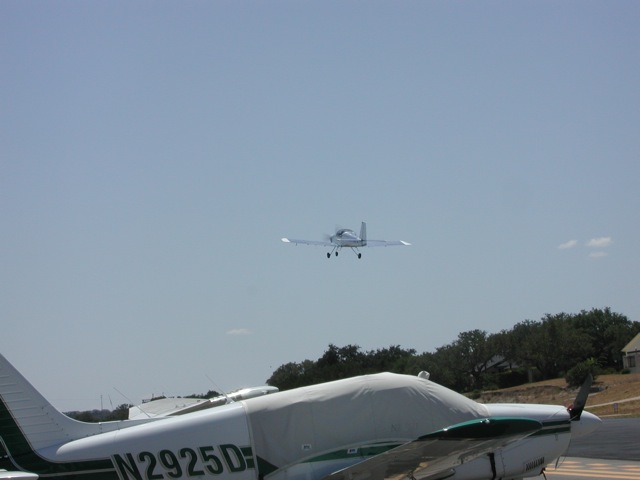
I circled over the airport for about 30 minutes trying to stay on track with my test flight procedures, but that was hard to do with no airspeed. Also the card called for 10 degree and 20 degree turns. Well, sorry, that would take me to Oklahoma. I ended up with 30 degree turns to stay close to the air strip. I climbed up to 4000 to try some slow flight, but didn't stay on task with this too long - kinda hard to do slow flight without knowing what slow is.
Then I decided it was time to come down. I had to go around twice because the plane really didn't want to slow down. I was trying not to use the last notch of flaps as per the test plan, but also I was never sure I was slow enough for full flaps. On the final approach I was still too high and hot, but tried out a slip. The plane responded well and I was able get down and lined up. But pulling the throttle all the way out still seemed to produce too much lift. I chopped both mags and pulled the mixture and finally she started slowing down. Still she floated till the hangars. I vaguely remember that the landing wasn't too terrible. Wind was calm.
When I taxied in and shutdown, they had to remind me to grin. I obviously wasn't following the checklist anymore.

Many thanks to Wayne and Cora Wagner who have given my project an airport home and tolerated my invasion of their hangar. Wayne has been there to help, especially the last month. He was providing a calming flight instructor influence today as I was obviously nervous and frantic. He also took all of these pictures.
I have to repeat flight card 1, but at least I know she flies!
Squawks:
Airspeed (fixed already, loose connection from the pitot/static check)
Brakes not releasing all the way. Classic RV problem. Need return springs.
Engine start at 1:13 and we took flight at 1:20pm. Wayne and Cora
were my ground crew.

She flew very well, except for the minor
distraction of no airspeed indicator. I check for controlability and then started a climb, turning to downwind about the same time. I thought for a second about returning immediately, but quickly decided to keep her in the air, climbing to 2000AGL. CHTs climbed pretty high, with #4 at 442. I backed out the power and lowered the nose and she cooled off nicely, staying around 400. Wish I could remember what the oil temp was. On the 430W I dialed up the page that shows ground speed, so I had some inkling of how fast I was. At about 2300 I was doing 125kts.

I circled over the airport for about 30 minutes trying to stay on track with my test flight procedures, but that was hard to do with no airspeed. Also the card called for 10 degree and 20 degree turns. Well, sorry, that would take me to Oklahoma. I ended up with 30 degree turns to stay close to the air strip. I climbed up to 4000 to try some slow flight, but didn't stay on task with this too long - kinda hard to do slow flight without knowing what slow is.
Then I decided it was time to come down. I had to go around twice because the plane really didn't want to slow down. I was trying not to use the last notch of flaps as per the test plan, but also I was never sure I was slow enough for full flaps. On the final approach I was still too high and hot, but tried out a slip. The plane responded well and I was able get down and lined up. But pulling the throttle all the way out still seemed to produce too much lift. I chopped both mags and pulled the mixture and finally she started slowing down. Still she floated till the hangars. I vaguely remember that the landing wasn't too terrible. Wind was calm.
When I taxied in and shutdown, they had to remind me to grin. I obviously wasn't following the checklist anymore.

Many thanks to Wayne and Cora Wagner who have given my project an airport home and tolerated my invasion of their hangar. Wayne has been there to help, especially the last month. He was providing a calming flight instructor influence today as I was obviously nervous and frantic. He also took all of these pictures.
I have to repeat flight card 1, but at least I know she flies!
Squawks:
Airspeed (fixed already, loose connection from the pitot/static check)
Brakes not releasing all the way. Classic RV problem. Need return springs.
Tuesday, August 23, 2011
3 hrs
Was supposed to be easy tonight but everything fought tooth and nail to not go together. The upper cowl should have taken about 5 minutes, took an hour. The spinner should have been easy. Until we discovered two munged up platenuts. Had to drill them out and rivet on new ones. Another hour and a half.

Then started working on the aileron trim. Needed to adjust the friction so it would hold more securely. Ended up just taking it completely out. At least it's ready to go back in.

Was supposed to be easy tonight but everything fought tooth and nail to not go together. The upper cowl should have taken about 5 minutes, took an hour. The spinner should have been easy. Until we discovered two munged up platenuts. Had to drill them out and rivet on new ones. Another hour and a half.
Then started working on the aileron trim. Needed to adjust the friction so it would hold more securely. Ended up just taking it completely out. At least it's ready to go back in.
Monday, August 22, 2011
2 hrs
Applied heat shield insulation to the inside of the cowl to protect against the hot exhaust tubes.
The way this worked is that Wayne had an idea how he wanted to do his, so we tried it out on mine. I think it worked out great. We used a hot rod market high temp spray on contact cement to tack on some upgraded heat sheild material. This stuff has a fiberglass backing and a high temp metallic shiny surface. It will reflect heat and insulate, good to ~1200 degrees (the material that is).
We cut it to shape and decided we needed to build up the corner of the cowl bottom to air inlet duct with a thin strip of material. This allowed the second layer to lay down better.
Jesse B. helped out a bit, and it was good to have an extra set of hands when messing with the contact cement.
Then we fit the lower cowl on to the plane. The exterior is looking ready to fly!
Applied heat shield insulation to the inside of the cowl to protect against the hot exhaust tubes.
The way this worked is that Wayne had an idea how he wanted to do his, so we tried it out on mine. I think it worked out great. We used a hot rod market high temp spray on contact cement to tack on some upgraded heat sheild material. This stuff has a fiberglass backing and a high temp metallic shiny surface. It will reflect heat and insulate, good to ~1200 degrees (the material that is).
We cut it to shape and decided we needed to build up the corner of the cowl bottom to air inlet duct with a thin strip of material. This allowed the second layer to lay down better.
Jesse B. helped out a bit, and it was good to have an extra set of hands when messing with the contact cement.
Then we fit the lower cowl on to the plane. The exterior is looking ready to fly!
Sunday, August 21, 2011
Airworthy!
Saturday, August 20, 2011
For Friday, Aug 19.
2 hrs
Finished up a couple more items from the list. Thursday night I installed the new Skyview backup battery. Now both screens will stay online when power is shutoff, up to 1 hour. Shipped the bad battery back to Dynon.
Extracted a spare general purpose input from the bundle behind the panel, routed it forward of the firewall. I will use this for the extra air temperature probe that I bought from Dynon. It can be moved around as needed in the engine compartment to understand the temperatures seen during flight and on the ground.
Also finally installed the black instrument panel screws for the left Skyview. The panel is now complete!
And replaced the bottom rudder attach bolt, there were no threads showing past the nut, and the tech counselor crew spotted it.
2 hrs
Finished up a couple more items from the list. Thursday night I installed the new Skyview backup battery. Now both screens will stay online when power is shutoff, up to 1 hour. Shipped the bad battery back to Dynon.
Extracted a spare general purpose input from the bundle behind the panel, routed it forward of the firewall. I will use this for the extra air temperature probe that I bought from Dynon. It can be moved around as needed in the engine compartment to understand the temperatures seen during flight and on the ground.
Also finally installed the black instrument panel screws for the left Skyview. The panel is now complete!
And replaced the bottom rudder attach bolt, there were no threads showing past the nut, and the tech counselor crew spotted it.
Wednesday, August 17, 2011
Not tracking time well anymore. Stopped by the hangar and took care of a couple of minor items from the Monday inspection list. Helped Wayne move his canopy into the house, that gets it out of harms way. Still a few things to go but now just nervously biding time till the inspection.
Oh. It's official, I have the Airworthiness Inspection on Sunday. Mel Asberry is flying down from the Dallas area, he's the DAR (Designated Airworthiness Representative) that knows more about inspecting RV's and experimentals than anyone else in Texas. He also taught the class I took last October.
If all goes according to plan, by Sunday evening Mel will be safely back in Dallas, and I will have a pink piece of paper that is the provisional airworthiness certificate, and a log book entry saying that Mel inspected N207LT and found it "in a condition for safe operation". He's an A&P, so he can do this, but I can't. At least not till I get my Repairman's Certificate.
You all know what comes next! Maybe not. Next I have to put the plane all back together because all the access panels will be removed for the inspection.
But THEN.......
Oh. It's official, I have the Airworthiness Inspection on Sunday. Mel Asberry is flying down from the Dallas area, he's the DAR (Designated Airworthiness Representative) that knows more about inspecting RV's and experimentals than anyone else in Texas. He also taught the class I took last October.
If all goes according to plan, by Sunday evening Mel will be safely back in Dallas, and I will have a pink piece of paper that is the provisional airworthiness certificate, and a log book entry saying that Mel inspected N207LT and found it "in a condition for safe operation". He's an A&P, so he can do this, but I can't. At least not till I get my Repairman's Certificate.
You all know what comes next! Maybe not. Next I have to put the plane all back together because all the access panels will be removed for the inspection.
But THEN.......
Tuesday, August 16, 2011
Bought a case of oil for the first oil change that will happen next week! Also picked up some hose suitable for the manifold pressure hookup. Installed it.
Helped Wayne for a little while, we are figuring out how to program the EIS, starting to get the ammeter and manifold pressure configured and working.
Helped Wayne for a little while, we are figuring out how to program the EIS, starting to get the ammeter and manifold pressure configured and working.
Monday, August 15, 2011
Tech counselor visit.
Deene, Seth, Jerry Stofer, and Dan Badwey of chapter 187.

Several items on the punch list, two big items.
Install missing cotter pins on the main control column bolts.
Tightened fuel pump outlet clocking lock nut.
Tighten starter contactor nut.
Set engine controls for 1/8" extra travel to prove positive stop.
They didn't like the safe air tubing for the manifold pressure line. The engine will get hot and may ruin the tubing. Also need a way to secure the MP line to prevent chafing on the heater air inlet.
A few other minor items some of which I found myself. Need to finish the wing tip wiring.
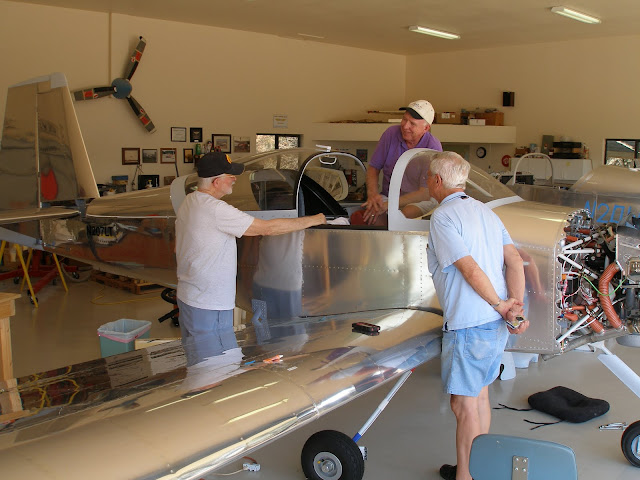
They advised not to burn in the brakes because of engine breakin needs. I had asked Seth about this over two years ago and he said there were no special requirements. But the cylinders do need normal breakin treatment, apparently.
Deene, Seth, Jerry Stofer, and Dan Badwey of chapter 187.
Several items on the punch list, two big items.
Install missing cotter pins on the main control column bolts.
Tightened fuel pump outlet clocking lock nut.
Tighten starter contactor nut.
Set engine controls for 1/8" extra travel to prove positive stop.
They didn't like the safe air tubing for the manifold pressure line. The engine will get hot and may ruin the tubing. Also need a way to secure the MP line to prevent chafing on the heater air inlet.
A few other minor items some of which I found myself. Need to finish the wing tip wiring.
They advised not to burn in the brakes because of engine breakin needs. I had asked Seth about this over two years ago and he said there were no special requirements. But the cylinders do need normal breakin treatment, apparently.
Sunday, August 14, 2011
4 hrs
Check and tighten firewall accessory through bolts.
Start diagnosing brake issue.
Resolve left side flap actuator interference issue.
Torque seal more bolts.
Install three inboard tank/spar bolts on right side.
Start installing crotch straps.
Was going to taxi to day to burn in the brakes, but we ran out of daylight.
Helped Wayne a bit, put the pitch servo in place. Figured out why his 420 was in demo mode. A pin had been caught wrong and bent over, and it was grounding the demo mode pin. Once we straighted the pin out it worked great. Got the 420 and right side Horizon talking. Now a flight plan can be entered on either GPS and both Horizon screens pick it up right.
Check and tighten firewall accessory through bolts.
Start diagnosing brake issue.
Resolve left side flap actuator interference issue.
Torque seal more bolts.
Install three inboard tank/spar bolts on right side.
Start installing crotch straps.
Was going to taxi to day to burn in the brakes, but we ran out of daylight.
Helped Wayne a bit, put the pitch servo in place. Figured out why his 420 was in demo mode. A pin had been caught wrong and bent over, and it was grounding the demo mode pin. Once we straighted the pin out it worked great. Got the 420 and right side Horizon talking. Now a flight plan can be entered on either GPS and both Horizon screens pick it up right.
Saturday, August 13, 2011
5 hrs
Mostly finished with cleaning up the FWF wiring. I think I'll always be able to find something I'd like to change.



These photo's look very busy. The real item is not quite that bad. It can be a bit hard to reach a few things, but you can see floor in lots of places.
Need to do some taxiing tomorrow to burn in the brakes.
Mostly finished with cleaning up the FWF wiring. I think I'll always be able to find something I'd like to change.
These photo's look very busy. The real item is not quite that bad. It can be a bit hard to reach a few things, but you can see floor in lots of places.
Need to do some taxiing tomorrow to burn in the brakes.
Wednesday, August 10, 2011
Tuesday, August 9, 2011
Monday, August 8, 2011
Sunday, August 7, 2011
Engine Start!
5 hrs
Spent the morning finishing up the FWF wiring cleanup. Remade the right side mag p-plead. Not completely finished, because we ran out of #12 adel clamps.
Removed and cleaned spark plugs. Dropped one, but Erik had some spares.
Pre-oil engine, purge oil and fuel pressure lines.
Rechecked all lines, Wayne looked at it also. We declared it ready for engine start.
Started the engine. It runs a lot better at full rich as compared to idle cutoff. Once I figured that out it started right up. I had prepared a test plan and mostly stuck to it. Ran it 4 times, first with out the alternator to verify the guages were alive, then with the alternator. Everything seems to work as it should, no noticeable leaks.
Taxied over to the fuel pumps to put in 10 gallons. On the way over, the left main brake is acting up a bit. Will need to diagnose this. The plane is a bit hard to steer with just brakes.
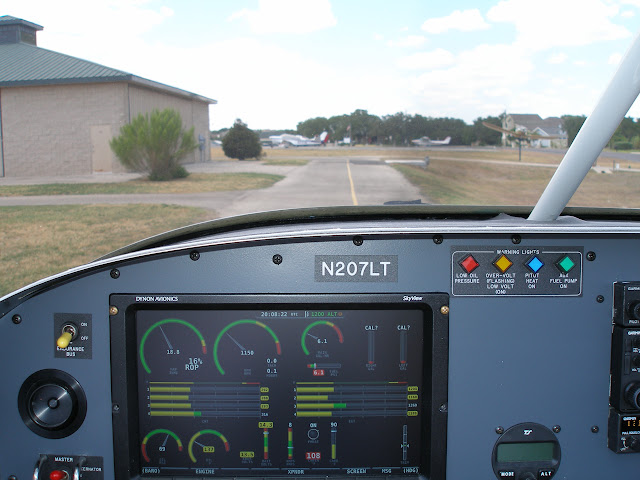

Readjusted the Dynon a bit, fuel pressure. The only guage not working is the fuel levels, and they need to be calibrated first.
Spent the morning finishing up the FWF wiring cleanup. Remade the right side mag p-plead. Not completely finished, because we ran out of #12 adel clamps.
Removed and cleaned spark plugs. Dropped one, but Erik had some spares.
Pre-oil engine, purge oil and fuel pressure lines.
Rechecked all lines, Wayne looked at it also. We declared it ready for engine start.
Started the engine. It runs a lot better at full rich as compared to idle cutoff. Once I figured that out it started right up. I had prepared a test plan and mostly stuck to it. Ran it 4 times, first with out the alternator to verify the guages were alive, then with the alternator. Everything seems to work as it should, no noticeable leaks.
Taxied over to the fuel pumps to put in 10 gallons. On the way over, the left main brake is acting up a bit. Will need to diagnose this. The plane is a bit hard to steer with just brakes.
Readjusted the Dynon a bit, fuel pressure. The only guage not working is the fuel levels, and they need to be calibrated first.
Saturday, August 6, 2011
Friday, August 5, 2011
3 hrs
Punch list items.
Set brake pedal cotter pins.
Stake gascolator screws.
Fit clamp to oil temp sender for safety wire.
Diagnose L skyview backup battery issue.
Continue installing aileron trim.
Strip more blue plastic.
Wayne was able to power up both Grand Rapids displays. We need to go through and setup everything.
Punch list items.
Set brake pedal cotter pins.
Stake gascolator screws.
Fit clamp to oil temp sender for safety wire.
Diagnose L skyview backup battery issue.
Continue installing aileron trim.
Strip more blue plastic.
Wayne was able to power up both Grand Rapids displays. We need to go through and setup everything.
Thursday, August 4, 2011
1 hr
Adjusted Dynon fuel flow settings. Set to 56400. Was 60000. Edit. That was the wrong way. Needs to be set to 65,800, which it now is.
Start installing aileron trim.
Strip more blue plastic.
Helped Wayne install his main EFIS connectors. We're done with that part of the wiring, now it's time to test it.
Adjusted Dynon fuel flow settings. Set to 56400. Was 60000. Edit. That was the wrong way. Needs to be set to 65,800, which it now is.
Start installing aileron trim.
Strip more blue plastic.
Helped Wayne install his main EFIS connectors. We're done with that part of the wiring, now it's time to test it.
Wednesday, August 3, 2011
First fuel added!
2 hrs, 4 gallons of fuel!
Removed wing root fairings to prep for adding fuel.
Added fuel and drained, both tanks, to wash out any crud. Nearly none.
Check for leaks. Doesn't appear to be any at this time.

Added fuel again, ran aux pump. Measured fuel flow rate, both tanks. We could fill a 1G container in 1 minute, 40 seconds from either tanks. That works out to 36 gallons/hr. The Dynon was indicating 39.5 gallons/hr. This is well above the 20GPH I needed to meet the recommended rate of 1.5 times max fuel flow rate.
Check for proper operation of fuel selector switch. Seems to work OK, including the off position. Switching tanks causes no noticeable change in flow rate.
Ran the right tank dry, measured unusable fuel. Less than 3 ounces.
Reattached all fuel lines and tightened them up.
For Tuesday, 2 hrs
Bought fuel and prepped for adding. Fuel is $5.29. Ouch.
Trimmed cowl attach strip for gascolator drain.
Install gascolator drain.

Monday helped Wayne with his wiring.
Removed wing root fairings to prep for adding fuel.
Added fuel and drained, both tanks, to wash out any crud. Nearly none.
Check for leaks. Doesn't appear to be any at this time.
Added fuel again, ran aux pump. Measured fuel flow rate, both tanks. We could fill a 1G container in 1 minute, 40 seconds from either tanks. That works out to 36 gallons/hr. The Dynon was indicating 39.5 gallons/hr. This is well above the 20GPH I needed to meet the recommended rate of 1.5 times max fuel flow rate.
Check for proper operation of fuel selector switch. Seems to work OK, including the off position. Switching tanks causes no noticeable change in flow rate.
Ran the right tank dry, measured unusable fuel. Less than 3 ounces.
Reattached all fuel lines and tightened them up.
For Tuesday, 2 hrs
Bought fuel and prepped for adding. Fuel is $5.29. Ouch.
Trimmed cowl attach strip for gascolator drain.
Install gascolator drain.
Monday helped Wayne with his wiring.
Subscribe to:
Posts (Atom)